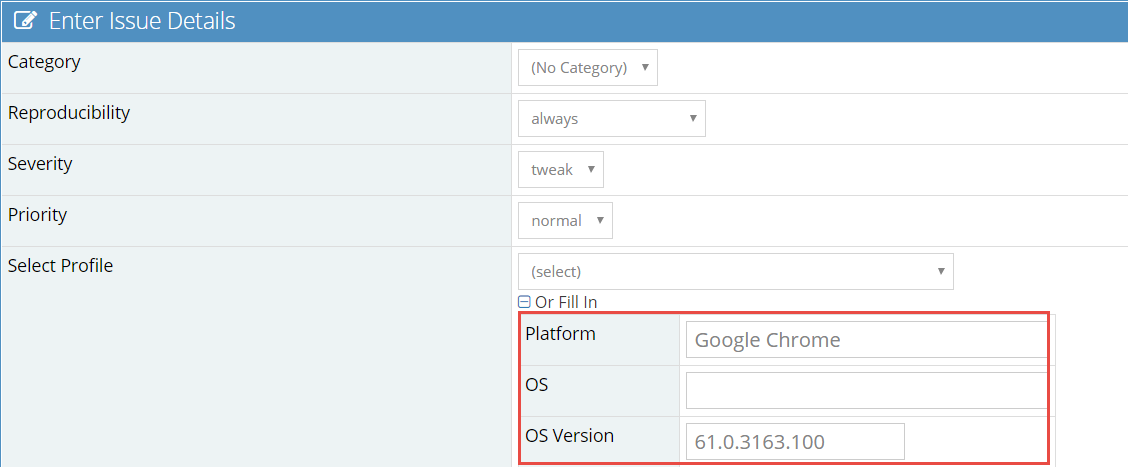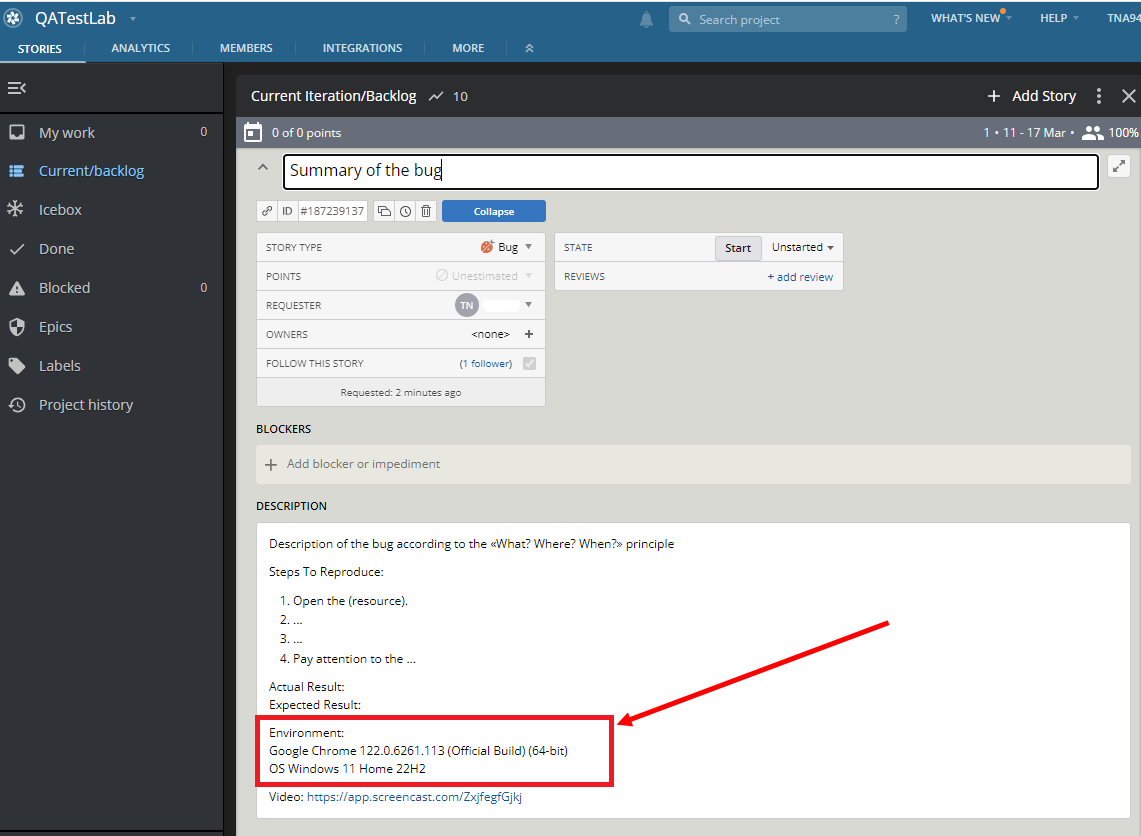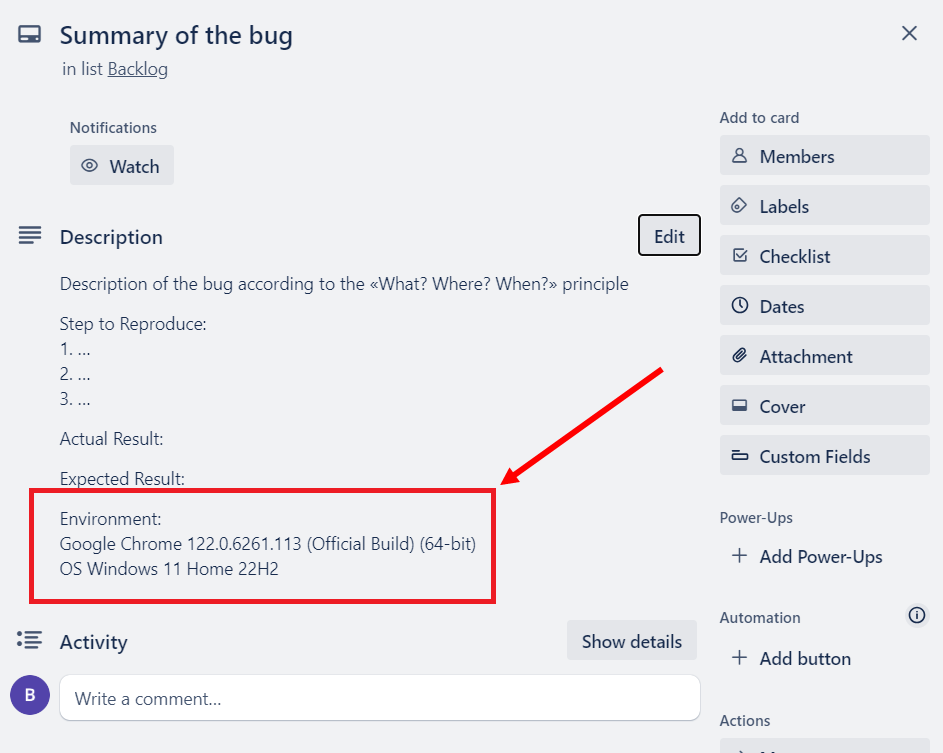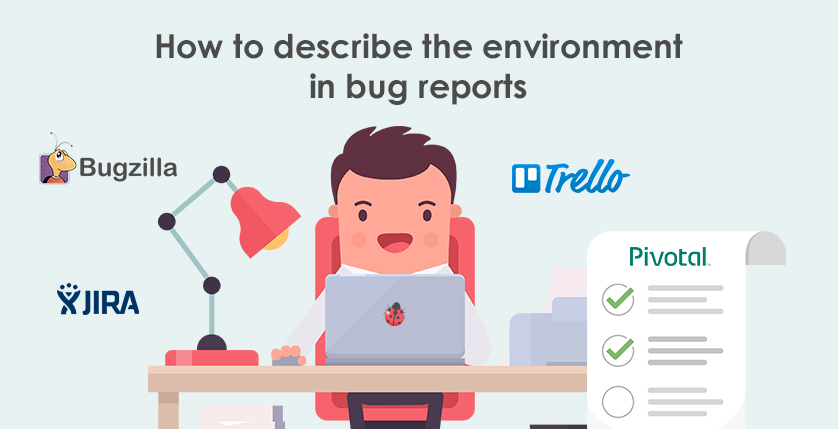What is Software Environment?
Software Environment – an environment on which the defect was found - operating system, browser, browser version, server, etc. If the defect is reproduced in all environments, then a corresponding comment is made.
Let's take a closer look at the 2 main types of environments, their types and versions:
- One of the environment types is the Operating System. This is the environment in which the user runs the program. For example, the DOS operating environment consists of all DOS commands available to the user. On the other hand, the Macintosh operating environment includes a graphical user interface that uses icons and menus instead of commands.
The composition of the environment can vary widely on various operating systems.
The most popular operating systems for the period 2020-2024 are:
- Windows family (versions: 7, 8,1, 10, 11), which has 32x and 64x versions;
- UNIX-like systems family LINUX (versions: Debian, CentOS, Ubuntu, Fedora, Mint);
- OS X family (Macintosh) last versions (Monterey 12.7.4, Ventura 13.6.6, Sonoma 14.4.1). It also includes a closed source operating system for mobile platforms;
- iOS. Last version: iOS 15; iOS 16; iOS 17. Apple is a company using and developing a series of software products macOS, iOS;
- Android – a free operating system for the mobile phones, tablets, smartwatches, TVs and smartbooks based on the Linux kernel, developed by Open Handset Alliance and owned by Google. Last versions: Android 12; Android 12.L; Android 13; Android 14.
- Browser – application software for web browsing, web-documents keeping, computer files and their directories, web application management, as well as solving other tasks. On the global network, browsers are used for requesting, processing, manipulating, and displaying the content of the website. A lot of modern browsers can also be used to exchange files with ftp servers, as well for viewing the contents of files in many graphic formats (gif, jpeg, png, svg), audio-video formats (mp3, mpeg), text formats (pdf, djvu) and other files.
Browser functionality is constantly expanding and improving due to competition between their developers as well as the high rate of development and implementation of information technologies.
There is a huge number of web browsers from different companies and countries, open and closed for use in certain regions and countries. Let's take a look at the most popular ones.
- Google Chrome – a browser developed by Google based on the free Chromium browser and the Blink engine (WebKit was used until April of 2013). Android operating system (Oreo or later), iOS (15 or later), Linux, macOS (10.15 or later), Windows (10 and higher).
- Microsoft Edge – a browser created by Microsoft, released in 2015 with the Windows 10 OS. The browser functions separately from Internet Explorer and does not replace it. Microsoft Edge can replace Internet Explorer in Windows 7, Windows Server 2008 R2 or later, but this web browser is not available in Windows Vista, Windows Server 2008 or earlier. Operating system: Android 8.0 or later, iOS 15.0 or later, macOS 10.15 or later, Windows 10, Windows Server 2016 or later, Linux (specifically Ubuntu, Debian, Fedora).
- Safari – browser developed by Apple and including macOS, iOS, iPadOS and visionOS. Safari is based on the freely redistributable WebKit engine. Operating systems: macOS, iOS, iPadOS, Windows (2007–2012).
- Mozilla Firefox – a free browser based on the Gecko engine, developed and distributed by Mozilla Corporation. Operating systems: Linux, macOS 10.15 or later, Windows 10 or later, Android 5.0 or later, iOS 15.0 or later.
- Opera – a web browser and web application suite produced by Opera Software. Developed in 1994 by a group of researchers from a Norwegian company Telenor. Supports operating systems: Windows, macOS, Linux, Android и iOS.
Let's have an example of how to describe the environment correctly while creating a defect ( Mantis, Jira, Pivotal, Trello and Bugzilla are taken as example)
Once you find a defect (failure, bug), it is required to report it as soon as possible using bug tracking systems. The top tip of the bug report creation: never put it off for later, if it can be created now. This advice applies not only to bug reports creation, but also to all the work of a specialist in the field of testing. Many testers neglect this simple rule and many defects remain unnoticed, affecting the quality of the product.
The bug report template depends on the bug tracking system being used. However, the following fields are commonly present in all popular systems:
- Unique identificator (ID)
- Severity
- Priority
- Environment
- Summary
- Description
- Steps to Reproduce
- Actual result
- Expected result
- Attached Files
Let's take a quick look at the bug report environment in bug tracking systems such as: Mantis, Jira, Pivotal, Trello и Bugzilla. The environment is necessary for the development team to fix bugs in the environment in which they were found.
The Mantis bug tracking system has several fields to describe the environment of the tested product:
- the «Platform» field (Browser, PC, Mobile phone etc.);
- the «Operating system» field (Operating system name [Windows, Mac, Linux]);
- the «OS Version» field (Operating system or browser version number).
Please, note that the figures below show examples of how to indicate the environment of the product under test correctly and incorrectly.
![]()
Example of the correct bug environment in Mantis BT
In the Mantis bug tracking system, information about the environment is entered into the «Platform, OS, OS Version» fields. From the screenshot above, you can see that the «Platform» field indicates the platform on which the testing was performed. The «OS» field indicates the operating system on which the testing was performed. The «OS Version» field indicates the operating system version.
Let's look at examples of the incorrect environment fields filling:

Example of the incorrect bug environment in Mantis BT
![]()
Example of the incorrect bug environment in Mantis BT
In the Jira bug tracking system the information about the environment is indicated in the «Environment» field. This field contains information about all data about the testing environment (platform, OS, OS version, build version, etc.).

Example of the correct bug environment in Jira BT
Let's take a look at the example of the incorrect environment fields filling in the Jira bug tracking system:

Example of the incorrect bug environment in Jira BT
In the Pivotal system the defect description, steps to reproduce, results and environment are written in the «Description» field.

Example of the correct bug environment in Pivotal BT
The project management web application Trello can also be used as a bug tracking system - the name of the created card will be a short description of the defect, and the steps to reproduce, the results and the environment will be indicated in the «Description» field.

Example of the correct bug environment in Trello
In the Bugzilla bug tracking system, all information about the environment is written in the «Version», «Hardware» и «OS» fields.

Example of the correct bug environment in Bugzilla
In this article, we considered the concept as «software environment», OS and web-browsers examples, bug reports templates in the most popular bug tracking systems Mantis, Jira, Pivotal, Trello and Bugzilla.
So, let's summarize briefly:
Software Environment – an environment in which the defect was found - operating system, browser, browser version, server, etc.
Operating system – an environment in which the user runs the program. The most popular ones: Windows OS (OS for PCs and for mobile platforms - Windows Mobile), Linux, Mac OS (OS for PCs and for mobile platforms - iOS), Android.
Browser – an application software for web browsing. The most popular ones: Google Chrome, Microsoft Edge, Mozilla FireFox, Safari, Opera.
When you find a failure (defect, bug) you need to create a bug report in the bug tracking system as soon as possible.
Basic fields required for filling in bug reports:
- Unique identificator.
- Severity.
- Priority.
- Environment.
- Summary.
- Description.
- Steps to Reproduce.
- Actual result and expected results
- Attached files.
Differences in the formulation of information of the testing environment (in the considered systems):
- In the Mantis system there are separate fields for describing the environment: «Platform», «OS», «OS Version».
- In Jira, all information about the testing environment data is specified in the «Environment» field.
- In Bugzilla, the information about the environment is specified in the «Version», «Hardware» and «OS» fields.
- In Trello and Pivotal there are no separate fields for describing the steps to reproduce, results and environment, therefore all this information is specified in the «Description» field.



